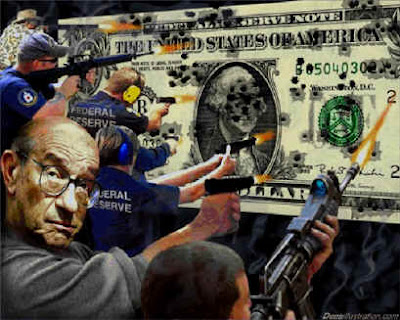The Horrible Conundrum Facing The Fed
 Courtesy of Karl Denninger at The Market Ticker
Courtesy of Karl Denninger at The Market Ticker
The Fed’s continued policy pronouncements that:
The Committee will maintain the target range for the federal funds rate at 0 to 1/4 percent and continues to anticipate that economic conditions are likely to warrant exceptionally low levels of the federal funds rate for an extended period.
[This] has set up a completely-untenable position for The Fed and the greater economy.
The problem The Fed and America faces is that this latest "blast of the liquidity firehose" is not limited to The United States in its impact.
Indeed, the problems that this sort of "monetary policy" generates have almost nothing to do with the US Economic picture – rather, they have everything to do with the international nature of markets and monetary flows and the impact that such a policy pronouncement has on them.
Specifically, The United States Dollar has become the primary funding currency for carry trades:
“The dollar is the big funding currency,” said Jonathan Clark, vice chairman of New York-based FX Concepts Inc., the world’s largest currency hedge fund, with $9 billion in assets under management. “The reason why people are borrowing the U.S. dollar for carry trade is A: It’s very cheap to fund, and B: The expectation is it’s going to go down.”
This is a tremendously destructive force for an economy, and is largely-responsible for Japan’s inability to return to economic prosperity and growth over the last 20 years – the Yen became a funding currency of choice.
But Japan had an advantage we do not – a weak currency benefited to a tremendous degree their exporters, and they are an export-based economy. As a consequence the damage done internally to import prices by the continued downward pressure on their currency was counterbalanced by an improving balance-of-payments picture.
America, on the other hand, has a huge trade deficit. Attempting to reverse this is essentially impossible as we have offshored production to low-labor-cost locales such as Vietnam and China. We are also absolutely dependent on foreign energy sources and despite 30 years of political promises to resolve that problem we have refused to take the steps necessary to do so, including funding massive nuclear energy development and drilling for all of our currently-known resources as a bridge while those nuclear plants are brought online. There is and has been zero political or public will behind accepting that resolving these problems does not lie in "pie in the sky" battery, solar and wind technologies, but rather through aquaculture-produced bioldiesel, massive nuclear power development and full exploitation of our existing fossil-fuel stores, all of which will cause energy costs to rise and exact what amounts to a tax on the American people. In short we demand not only cheap TVs from China and cheap blue jeans from Vietnam but cheap gasoline from Saudi Arabia, and combined this makes addressing trade imbalance politically impossible.
Depreciating our currency makes internationally-represented firms such as Caterpillar happy, but this is a short-term phenomena, as competing producers in China can (and will!) over time cannibalize their sales into that market since their labor costs are so low.
We simply cannot afford to allow a self-reinforcing cycle to become established with dollar-funded carry trades. There is a line beyond which the depreciation in the dollar causes such a trade to become self-reinforcing and extraordinarily destructive. Exactly where that line happens to be is difficult to determine but that a profit/reinvestment cycle "kneepoint" exists is axiomatic.
Should we reach that point the dollar will come under attack in the FX markets to a degree that is literally impossible to stem. FX markets move a couple of trillion dollars a day – intervention in those markets is both insanely expensive and futile over any material amount of time.
This is what those who are sounding the alarm over a potential currency collapse see in the future – and the risk they are speak of is in fact very real.
 The only real means of defense against such a self-reinforcing cycle is to limit the number of dollars in circulation. This means raising interest rates – either formally or effectively – through withdrawal of liquidity – forcing an unwind of these trades and raising the uncertainty level high enough that traders will not risk ruin – in other words, we must transform a near-sure-thing to a likely-bad outcome.
The only real means of defense against such a self-reinforcing cycle is to limit the number of dollars in circulation. This means raising interest rates – either formally or effectively – through withdrawal of liquidity – forcing an unwind of these trades and raising the uncertainty level high enough that traders will not risk ruin – in other words, we must transform a near-sure-thing to a likely-bad outcome.
This is the flaw in Benranke’s central thesis – that The Fed can continually respond to challenges in the economy by making money "cheaper" with each iteration. History shows that indeed this is exactly what Bernanke and his predecessors have done, both formally in The Fed Funds rate and informally through intentional and willful loosening of the constraints on leverage and lending.
Yet this is a road that leads, ultimately, directly to Hell’s Gate and somewhere along the line is a one-way trap door.
There is a limit in the economy on debt service at a given level of GDP. The available "slack" between the current interest rates being charged and the maximum sustainable interest rate before default becomes inevitable is the "safety margin" that allows monetary policy to work.
By intentionally eroding that margin over time The Fed has now backed itself into a corner; it reached the "zero rate" boundary and yet wanted even more easing, so it began monetizing debt.
This is as clear of a declaration you will ever see that the economy will not support higher interest cost even with the formal Fed Funds rate at zero.
In aviation circles there is a concept called "the coffin corner" where one approaches the speed of sound in an airframe that is not rated for transonic operation. Briefly as altitude increases the speed at which the plane must travel to produce sufficient lift to keep the plane in level flight goes up. Yet lurking up there is the critical mach number – the point where airflow over the wing approaches Mach 1 (a wing produces lift because the air going over the top surface must travel a greater distance, and therefore there are fewer molecules of air present in a given area over the wing than below – thus, lift) and produces a dramatic increase in drag and/or change in the pressure gradient. If the pilot increases speed to compensate for the loss of lift at higher altitudes he gets closer to the point where loss of control happens due to the latter phenomena. When that margin gets too small something as simple as an ordinary turn (which causes a change in the apparent angle of attack between the inside and outside wings) or turbulence can cause the plane to either exceed its critical Mach number or experience a stall, leading to loss of control.
This is the sort of "needle-threading" exercise that Bernanke is now engaged in, yet he continues to press the envelope further and further, intentionally ignoring the hard numerical facts that continue to mount – we have exceeded the maximum debt-carrying capacity in the system and are now turning to outright fraud to hide defaults and insolvencies that have already occurred!
This is an unstable circumstance that must not be allowed to continue. Rather, the authorities must insist on the immediate reduction in systemic leverage and the recognition of hidden defaults, even if this forces major financial institutions out of business, accepting the damage that will accrue to the economy.
The reason for this need is clear: The damage we have accumulated over the last 30 years remains smaller than the damage we will take going forward if we do not quit screwing around.
That is, the current loss is the best and in fact smallest loss. This was true in 1987, it was true in the 1990s, it was true in 2001 and was true in 2007.
We have a 30 year unbroken time line of proof that attempting to hide systemic damage and bad debt does not make it go away – it simply hides it in the corner and then piles more bad debt on top of it.
Those who have claimed that we "must not" disrupt these large institutions and that such would cause "unthinkable" economic damage have been repeatedly caught telling only half the truth.
Yes, the damage will be severe, but that is in fact precisely why we must accept it now: it has only gotten continually worse since the 1980s as we have continued to hide rather than accept this damage, and those who have claimed to be able to prevent and reverse the damage have repeatedly, over a 30 year time span, been proved wrong.
Third image down: Courtesy of Elaine Meinel Supkis.


